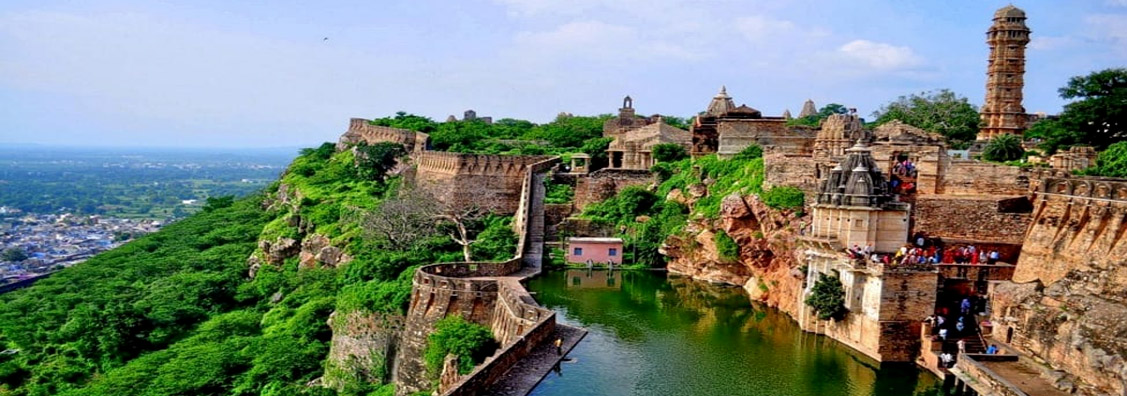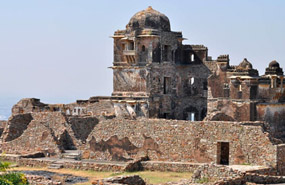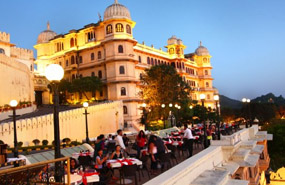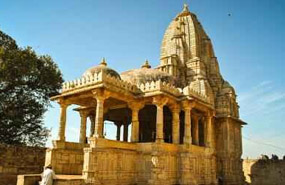

Home / Attractions / Chittogarh
Chittorgarh is the administrative headquarters of Chittorgarh District and was a former capital of the Sisodia Rajput Dynasty of Mewar. Rajasthan's most romantic name is Chittor. Chittor, the mention of the name brings to mind gallant heroic Rajput kings exhibiting bravado and valour. A small district mainly known for its fort perched upon a hill, Chittorgarh is an important tourist place in Rajasthan. Chittorgarh is a city in Rajasthan state of western India. Chittorgarh was founded by Bappa Rawal in 8th century, it is located at an elevation of 408 mts above sea level. Chittorgarh city is located on the banks of river Gambhiri and Berach. Mirabai, 16th century poet and Rani Padmini belongs to Chittorgarh. Chittorgarh is known for its massive fort which is 3 miles long and 495 feet high and also for Kirtistambha (Tower of Victory) and Vijaystambha.
A perfect reflection of the opulent Rajput history, Chittorgarh is a traveller's opportunity to have a rendezvous with glorious past. Rich in architecture splendour, Chittorgarh's prized possession remains its mighty and majestic fort, which indeed is a fine example of Rajputana architecture. This, one of the best sigtseeing places in Rajasthan once was exalted for its eighty four waterfronts. Alas, a few remain today and all of them are either rain fed or are natural areas of catchment. Tourism in Chittorgarh has increased manifold after the UNESCO declared it to remain preserved as a World Heritage Site in the 2013 convention. The estimated population of Chittorgarh City was 1.05 million in year 2011
Chittorgarh is the essence of Chattari Rajput pride, spirit and romance, people of Chittor always chose death before surrendering against anyone. It is a symbol of all that was true, brave and noble in the superb Rajput tradition. It is believed historically that Chittor was built by the Maurya dynasty. Mauryan rule ended in 271 B.C. as a dominant power in India. Chittaur was attacked three times and on each occasion the rite of Jauhar was performed.
The first attack was by Alauddin Khilji, the Sultan of Delhi in 1303 AD who was enamoured by the beauty of Padmini whose face he had seen reflecting on a mirror. Rani Padmini preferred death to abduction and committed jauhar along with all the other ladies of the fort.The second was in 1533 when the Sultan of Gujarat attacked Bikramjeet of Chittaur. Rani Karnavati, a Bundi Princess, take the jauhar in which many children and women perished. The ultimate sacrifice for freedom Jauhar was again performed for the third time after the Mughal Emperor Akbar captured Chittorgarh in 1568. Then the capital was moved west to Udaipur in the foothills of the Aravalli Range where Rana Udai Singh II had established a residence in 1559. Udaipur remained the capital of Mewar until it acceded to the union of India in 1947 and Chittorgarh gradually lost its political importance. Chittorgarh remains replete with historic associations and holds a very special place in the hearts of Rajputs, as it was a bastion of the clan at a
time when every other stronghold had surrendered to attack. It is often called as the "Bhakti aur Shakti ki nagari"
Several attraction of Chittorgrah City are described below-

Chittorgarh Fort has received the credit of being the largest fort of India. The massive fort is located on a high hill near the Gambheri River in Chittorgarh. Chittorgarh Fort lies at a distance of 112 kms from the city of Udaipur in Rajasthan. This fort was built by various Maurya rulers in the 7th century. This huge fort covers an area of 700 acres, extending to 3 kms in length and 13 kms in peripheral length. Standing on an elevated hill of 180m, the impregnable fort has witnessed three battles.
Chittaurgarh Fort is truly an embodiment of chivalry and pride of the Rajputs. The fort has a long story of romance, courage, determination and sacrifice. A glimpse of the fort still makes one to think the glory of the Rajputs who once lived here. The imposing Fort boasts of well-designed palaces, magnificent cenotaphs and huge towers. The Fort of Chittorgarh has a colossal structure that is secured by its several strong gateways.
Chittorgarh Fort is an acknowledgement to the courage of the gallant Rajput rulers who sacrificed their life combating dominant rivals instead of surrendering before them. The history of this majestic fort can be traced during the time of Khilji's. Chittorgarh Fort is said to have been the capital of the Gahlot and Sisodia kings who ruled Mewar between the eighth and the sixteenth century. The Fort was named after Chittrangad Maurya.
The fort was attacked three times and every time it got saved by the daring heroism of the Rajput warriors. In 1303, for the first time, this fort was attacked by Allaudin Khilji to fulfill his desire to make off with Rani Padmini. For the second time, the Fort was sacked by Sultan Bahadur Shah of Gujarat in 1535. In 1567, it was attacked for the last time by Mughal Emperor Akbar to conquer Maharana Udai Singh. Every time, a jauhar (mass suicide) was observed and the womenfolk of the Royalty never submitted themselves.
This colossal fort is accessible through seven huge gates (Pols) that are comprised of strong iron spikes and served as a watch tower in earlier times. The way to Chittorgarh Fort will take you through crisscross paths that would be interrupted at intervals by seven giant pols (gateways). The foremost gate you will come across is the 'Ram Pol' (the gate of Lord Rama) that has a temple in its vicinity. While climbing further, you would find two cenotaphs near Padal Pol. These cenotaphs are dedicated to Jaimal and Kala, who were killed by Akbar in the battle of 1567.
On your way, you will find Padal Pol, Bhairon Pol, Ganesh Pol, Jorla Pol, Lakshman Pol and Hanuman Pol. Next to Padan Pol, there is the memorial which was erected in the memory of Rawat Bagh Singh. He was the one, who got united with King Vikramaditya to battle against Sultan Bahadur Shah. The Bhairon Pol was named to memorize Bhairondas Solanki, who also fought in opposition to Sultan Bahadur Shah in 1534. However, the main gate to enter the fort is Suraj Pol (the Sun Gate).
Apart from these massive gates, the Fort has many palaces to boast of including Rana Kumbha Palace and Padmini's Palace, which are wonders of Rajput architecture. Padimini's Palace is the same palace that used to serve the beautiful queen of Rattan Singh. Rana Kumbha Palace is the place that has underground cellars where queen Padmini committed 'Jauhar' along with the children and the other ladies of household.
The Fort also comprises several temples including Sammidheshwara Temple, Jain Temple, Kalika Mata temple, Neelkanth Mahadev Temple, Meerabai Temple and Kumbha Shyam Temple. These are the ancient temples that have noteworthy carvings and intricate work. Gaumukh reservoir and Bhimtal Tank are other places worth visiting. Gaumukh reservoir is a huge water tank that gets water from Cow's mouth shaped rock. In the waters of this same reservoir, Allaudin was allowed to see the reflection of Queen Padmini that led to the whole battle.

Rana Kumbha Palace is situated inside the Chittorgarh Fort in Rajasthan. It is located near the Vijay Stambha close to the entrance gate, It is only about 5 Km distance from the center of Chittorgarh fort, The ruins of the once famous palace have the temple of Lord Shiva, Zanana mahal, Diwan -e -aam, along with a stable for horses. According to the legends, the founder of the city of Udaipur, Maharana Udai Singh was born here, and his life was saved by his wet nurse Panna Dai, who hid him inside a fruit basket. This place was once the home of the famous bhakti poetess Meerabai. It is also believed, that Rani Padmini organized her self- immolation or jauhar inside this fort.
The fort is build with stones which are plastered, and have some exquisitely design canopied balconies. It is said that this palace is haunted by spirits. Across from the palace a museum has been constructed. This palace was believed to be build by Bappa Rawal in 734 A.D Later, during the period of his reign, Maharana Kumbha renovated it, and then onwards this was named after him.

The palace served as Rana's residence. Rana Fateh Singh intended to showcase his inclination towards art and culture through this construction. Chittorgarh lies on the Golden Quadrilateral Highway system. It is near City Palace.
The palace is studded with numerous corridors and pillars built in Rajasthani style. It is beautifully decorated with wall paintings showcasing legends from Rajasthan belonging to the 17th. and 19th.centuries. In 1968, a large portion of Fateh Prakash Palace was converted into a museum.
Rana Fateh Singh had a fetish for art and same gets manifested in his collection of artifacts found in the Fateh Prakash Palace. The collection was rare and galore and hence later were housed in a museum. There are numerous sculptures. However, a special mention is needed for Ambica, Indra belonging to the post medieval period. These statues were found during excavation of the Rashmi village. There is a big idol of Lord Ganesha which dates back to the 8th to 9th century. It was brought from Pangarh. The craftsmanship in wooden idols displayed at this palace are of Bassi village.
The museum also houses a large collection of crystal items. These were supposedly collected by Maharana Sajjan Singh from F & C Osler Company in England.
In one section of the palace are placed the collection of the royal furniture. These include the dining tables, dressers, bottles, which once contained perfumes and sofas and so on.
There is a separate section dedicated for the display of the weapons used during that period. Such as helmets, knives, shields, axes, farsa etc. Uniforms of the persuasive soldiers of Chittorgarh are also on display.
The location of the palace and museum within the Chittorgarh Fort is in itself an attraction. The fort has been declared as a World Heritage site by UNESCO. It is the reckoned to be the largest fort in India as well as Asia. The fort is in the shape of a fish. Sprawled over 700 acres of land on a 180m hillock. It was built by the Mauryans in 7th century AD. Some believe it was built by Bhim of the Pancha Pandavs and is considered as an epitome of bravery.
This fort has witnessed the performance of Jauhar thrice. Initiated by Rani Padmini and carried forward by Rani Karnavati. To escape disrespect in the hands of enemies, women and children would sacrifice their lives by jumping alive into fire.

Chittorgarh is the place where Meera Bai was born who was a Rajput princess and is also being well known as a poetess and saint. The princess had given up her lavish lifestyle and dedicated her life in the worship of Lord Krishna. The Meera temple is constructed to be dedicated to her and is a very famous Hindu temple which is a must visit on your tour to Rajasthan. The splendid work of art on the temple attracts a large number of tourists. The temple reflects the Indo-Aryan style of architecture which was very famous in those times and is still a part of our cultural heritage. The Meera Bai temple and the Kumbha Shyam temple are both built on the same ground. On the outer side of the Meera Bai temple you will notice a carved statue of five human bodies with one head which symbolizes the fact that people of all castes and creed are the same and no differences exists among them. It is also of sign of tolerance. The temple has a beautiful statue of Lord Krishna and the Kumbha Shyam Temple has a black colored statue of God Garud. The temple organizes special functions on Meera Mahotsav when many devotees visit the shrine to offer their prayers. On the outer side of the temple there is a chhatri where the footprints of Raidas had been made who was the teacher of Meera Bai. The shrine has a spiritual ambiance and imparts peace in the minds of the visitors. It has both religious as well as historical relevance which makes it an important place of Chittorgarh.
During the rule of Rana Kumbha, the Meera Bai temple was built. He had constructed many other Hindu temples of which this one is the most eminent of all. Meera was a Rajput princess who was madly in love with Lord Krishna and had committed her whole life to Lord Krishna. This shrine had been mainly built so that Meera could worship Lord Krishna in Chittorgarh.

Right at the heart of the Chittorgarh Fort, the garrison that the Rajputs cleverly built to take advantage of the naturally rocky terrain, stands the Rani Padmini Palace. The once beautiful and stately, albeit small structure is now in an advanced state of disrepair. And yet, it stands out as a touch of femininity in the midst of what is obviously a soldier's world. The fort itself stands atop a 180 metre tall hill, making use of the natural settings to make it impregnable. Spread over about 700 acres, the Chittorgarh fort is believed to have been originally constructed in the 7th century.
Rani Padmini's Palace makes for a visual treat. It is one of the earliest palaces constructed in India to be completely surrounded by water. The queen's ill-fated but legendary beauty is reflected in the lotus pool that surrounds her small but stunning palace. The architectural style is distinctly Rajasthani, but hints of the Persian influences that had started to make their presence felt in India at the time. While there are certainly many parts of the Chittorgarh Fort that may be listed on tour guides and perhaps cry out for attention, the queen's palace combined with its history make this an unforgettable and attractive part of the fort.
